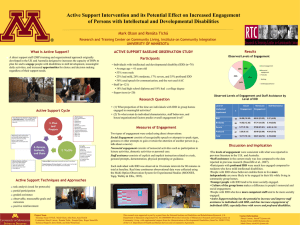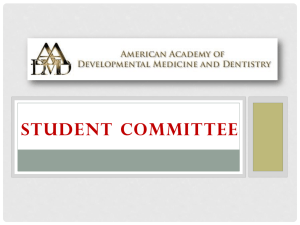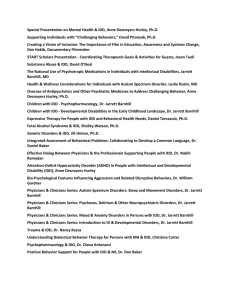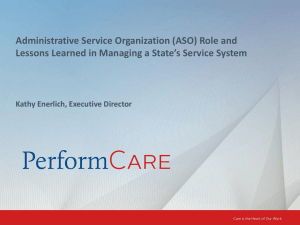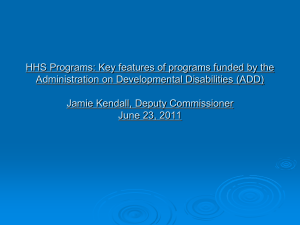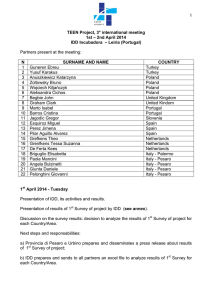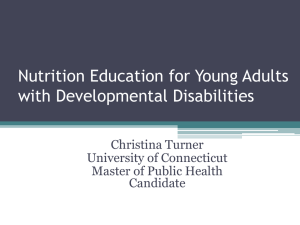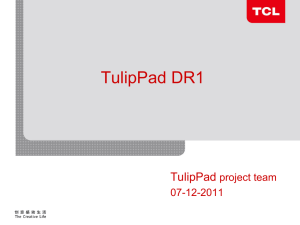Handout 1
advertisement
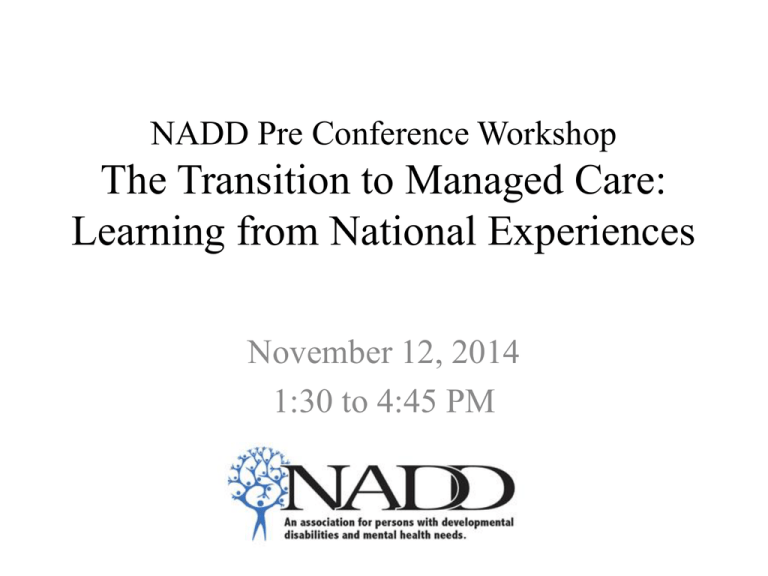
NADD Pre Conference Workshop The Transition to Managed Care: Learning from National Experiences November 12, 2014 1:30 to 4:45 PM Focus This Pre Conference Workshop addresses the recent NADD Public Policy Position Statement and its focus on understanding the nation’s growing use of pubic and private managed care services to meet the needs of individuals across all age groups who have a developmental disability and co-occurring mental disorder (psychiatric and/or substance use). Before We Get Started Who’s here? Your questions or topics of particular interest? Presenters Moderator: • Diane Jacobstein, PhD Clinical Psychologist/Senior Policy Associate Georgetown National TA Center for Children’s Mental Health, Washington, DC NADD Public Policy Position Statement: • Eileen Elias, MEd Disability Services Center Director, JBS International, North Bethesda, MD Provider Perspective & Lessons Learned: • Terry McNelis, MPA, Senior Vice President & Corporate Director of ID/D Services, NHS Human Services, Philadelphia, PA Presenters continued Administrative Services Organization (ASO) Role & Lessons Learned in Managing a State’s Service System: • Kathleen Enerlich, MA, Executive Director PerformCare, New Jersey Private Managed Care and Lessons Learned in Managing a State’s Service System: • Christina Carter, MSW, Chief Operating Officer, Smoky Mountain Managed Care Organization, Asheville, NC Important Issues for this Population • Extremely diverse • MH issues often misunderstood, diagnostic overshadowing • Medical issues often precipitate crises • Overuse of medication, side effects • Poor match between person and environmental demands • High incidence of trauma, often overlooked • Risk for institutionalization, incarceration, homelessness Stress for families can be unrelenting • Long and painful searches for services • Many people do not receive appropriate treatment • Often involved with multiple systems, poorly coordinated • Families may stay home, become isolated • Secondary MH issues for parents, siblings • Custody relinquishment (and divorce) sometimes a requirement to access public services Important Services- Often Hard to Find • Comprehensive evaluation • Disability-specific expertise at the clinical and programmatic level • Expanded service array including respite, occupational therapy, alternative communication • Preventative supports instead of symptom management • Effective crisis prevention New Georgetown National TA Center Resource: Effective Strategies Checklist: Children and Youth with Developmental Disorders and Challenging Behavior http://gucchdtacenter.georgetown.edu/publications/Effect ive%20Strategies%20Checklist%20FINAL.pdf Guiding Values and Principles based on Stroul, Blau & Friedman, 2010* • • • • • Individualized Community-based Family/consumer-driven (Self-determination) Youth- guided Developmentally appropriate (and developmentally evolving) * http://gucchdgeorgetown.net/data/documents/SOC_Brief2010.pdf • Culturally and linguistically competent • Using evidence-informed and promising practices • Integrated care coordination such as Wraparound or START coordination • Least restrictive, most normative environments • Integrated at the system level Pre Conference Meeting Goal Ensure that persons with co-occurring Intellectual/Developmental Disabilities (IDD) and mental illness receive the quality of care necessary for successful community based living. This involves areas such as long term supports, behavioral health, as well as physical health care. Educational Objectives Objective One: Understand why individuals with developmental disabilities and co-occurring mental illness must be addressed as a core constituency and not a special population group. Objective Two: Understand why and how state IDD and Mental Health authorities are increasingly relying on public and private managed care to stretch available dollars, coordinate services, and document outcomes. Educational Objectives continued Objective Three: Understand the lessons learned and challenges faced by a private managed care organization charged to administer and coordinate systems of care for individuals with developmental disabilities and co-occurring mental illness. Objective Four: Understand the stakeholder role and that of NADD in guiding the development of managed care to assure adequacy of communitybased services for individuals with developmental disabilities and co-occurring mental illness. NADD Public Policy Position Statement Eileen Elias, MED Director Disability Services Center JBS International And NADD Public Policy Committee Chairperson NADD Public Policy Position Statement • NADD’s Public Policy Position Paper titled “Including Individuals with Intellectual/Developmental Disabilities and CoOccurring Mental Illness: Challenges that Must Be Addressed in Health Care Reform” • Located at (http://thenadd.org/about-nadd/naddposition-papers/). • Over thirty organizations officially endorsed the NADD Public Policy Position Paper. NADD Public Policy Statement In order to advance the Public Policy Statement, NADD held a Strategic Planning Meeting on October 20, 2014 including high level representatives from the following organizations: (1) family members; (2) non-profit disability association executives; (3) federal government including the Center for Medicaid and Medicare Services (CMS), SAMHSA, and Administration for Community Living (ACL); (4) 3rd party insurers and managed care organizations (MCOs); (5) NADD Public Policy Committee members; (5) service providers; and (6) other pertinent stakeholders from both the public and private sectors. Policy Statement Overview • The nation’s response to the service needs of individuals of all ages with co-occurring IDD (e.g., autism) and mental illness (MI) is of concern. • Nationally, State IDD and mental health (MH) authorities are responsible for funding and monitoring needed services, yet support and funding is uneven. • An increasing number of publicly funded programs are hard pressed to provide the levels of assistance, therapy, primary care, long-term medical oversight and individualized supports that people with these cooccurring conditions need to live, work, and lead regular lives in the community. Prevalence of IDD/MI It is important to recognize that this group makes up approximately one-third (32.9%) of the total number of individuals with IDD served by state developmental disability (DD) agencies nationwide. The National Core Indicators data document the stability of this rate over time. Prevalence of IDD/MI Service Challenges • Improvements in services for people with IDD/MI have been achieved by many states during the past decade by expanding supports furnished under the CMS Home & Community-Based Medicaid Waiver programs and state funding of improved crisis services and increased access to mental health services. • While advances have been made, state DD and MH authorities and service systems continue to struggle to provide effective and appropriate treatments and supports on a consistent and comprehensive basis. • State efforts to establish and maintain coordinated systems of care for people with these co-occurring conditions have been significantly hampered by administrative and funding barriers that diffuse responsibilities and by the limited use of best practice models. • Dramatic declines in state revenues coupled with personnel reductions and a faltering economic recovery, have eroded the capacity of state agencies to maintain services. In many areas waiting lists have grown and access to needed supports are delayed, deferred, or discontinued. State Actions Several states and private providers are looking for ways to stretch funding by coordinating services and improving support outcomes using: – Home and community-based services under the Section 1915(c) Medicaid waiver program and the 1915(i) state plan option. – Self-directed personal care through the new 1915(j) state plan services or using the 1915(k) Community First Choice personal care option to assist individuals with living in their homes. – Federal programs such as Money Follows the Person (MFP) and the Balancing Incentive Payment (BIP) programs, which provide increased federal financing to states moving people from institutions to home and community-based settings. – New federal strategy, the Health Home, to improve the coordination of primary, acute, behavioral health, and long-term services and supports for individuals with two or more chronic conditions. State Actions • Some states are pursuing managed care as one of several strategies to decrease expenditures and improve service coordination. • Managed care approaches have been used to organize the delivery of acute health care and behavioral health services for some time. • The application of this model to long-term supports including Medicaid waiver-based programs furnished to people with IDD is limited. • At this time, Arizona, Michigan, North Carolina, and Wisconsin operate managed long-term care for persons with IDD including people with IDD and co-occurring MI. Kansas is moving the IDD population into managed care, and Louisiana and several others states are considering similar moves. • Persons with IDD may receive mental health services through managed mental health programs such as Health Homes. Manage Care Implications • Managed care proponents state that the approach offers benefits to states: – Enables policymakers to more closely align program expenditures with treatment and service outcomes – Improves administrative and operational efficiencies – Reduces costs over time. • Changing the structure and functioning of state IDD and MH service systems to adopt to either public or privately administered managed care is a complex undertaking. Managed Care Implications • The National Council on Disabilities’ recent report underscores the importance of the state’s role in managing Medicaid service delivery if the plans are operated by states, other public agencies, county governments, nonprofit organizations, or for-profit corporations. – The authors recommend that states retain staff with knowledge and expertise of disability services including community long-term services and supports, provide effective management and oversight and ensure high quality of care through MCO contracts and obligations. – The authors identify 24 policy-related issues and offer several recommendations for both federal and state policymakers. Managed Care Implications • Managed care systems are designed to reduce expenses while maintaining quality and improving outcomes. • Service costs and utilization are controlled through highly structured contracts among the state as the purchaser, the health plan(s), and the service providers. • Contracts between the state agency and the MCOs should specify funding mechanisms, service delivery arrangements, and the nature of the relationships of the various parties. Managed Care Implications • Specific contract provisions are implemented through separate but related administrative protocols described in operations and policy manuals. – Written by the state, these documents should identify MCO obligations with respect to the to be purchased and provided services and supports. – States must clearly identify the nature and scope of services to be furnished to people with co-occurring disabilities including service coordination, provider qualifications, oversight, quality management, cost-effectiveness, and steps to ensure coordinated care occurs among state agencies, providers, and others. MCOs and States Attention re Individuals with IDD and Co-Occurring MI • People with co-occurring needs are very heterogeneous, and their support needs change over their lifetime. • Individuals with IDD and co-occurring MI require a flexible array of services to help them effectively reside in the community. • States’ managed care funding models need to be designed to promote this flexibility and to support providers’ ability to structure services around the needs of the individual – children and adults. Strategic Planning Recommendations 1. Community Living 2. Knowledge and Expertise 3. Person-Centered Services 4. Workforce Competencies and Training 5. Readiness 6. Review Funding 7. Support for Families 8. Inter-Systems Service Coordination 9. Specifications in State Contracts with MCOs 10.Specifications for Public and Private Insurance Benefits and State Contracts with MCOs 11.Support to Develop Proven Models of Care and Treatment Provider Perspective Lessons Learned One Individual at a Time Terrence McNelis, MPA Executive Vice President NHS Human Services www.nhsonline.org Who is NHS Human Services • Large Not for Profit Multi-Service Organization • Located in 8 States Pennsylvania New York New Jersey Delaware Virginia Maryland Louisiana Michigan • Services Provided IDD Services Adult Behavioral Health Children’s Services Education Confidential - NHS Human Services - Not for Reproduction Intellectual & Developmental Disabilities Services • Located in 4 States ▫ PA, NJ, DE, VA • Residential Settings ▫ Group Homes, Shared Living, Supported Living, Independent Living • Employment, Day and Vocational Programs ▫ Community Integrated Employment, Community Day Programs, In Home Supports • Specialized Services ▫ Behavior Specialists, Dual Diagnosis Treatment Team Confidential - NHS Human Services - Not for Reproduction Lessons Learned • NHS has a history of moving challenging people out of State Centers • Stand alone Group Homes or Supported Living • Staff Turnover • Staff Support Confidential - NHS Human Services - Not for Reproduction Environmental Scan • Limited Dollars available • Fractured System • Increased Challenges in Serving Persons w/ ID and MI. • 33% of 1% Considered “Boutique” Population Confidential - NHS Human Services - Not for Reproduction Essential Ingredients • Transparency and Communication among all Stake Holders Individual Served Family Payer Case Management IDD Provider Mental Health Provider Primary Care Provider Other Stakeholders Stable DSP work force is essential • Stable DSP Workforce • Defined Outcomes and Expectations • Flexibility in the Payment Options Confidential - NHS Human Services - Not for Reproduction Things we have learned • The better the knowledge of Dual Diagnosis the better the yield • NHS is having NADD Certification and Accreditation of its DDT Teams • ISP contains efforts to treat MI • External Supports such as START or DDT Team • Cutting Costs up front = Greater Costs Later Confidential - NHS Human Services - Not for Reproduction Preferences • Working with MH Providers and Primary care facilities that are trained in Dual Diagnosis • Pay Per Month or case rate versus FFS • Knowledgeable MCO in Dual Diagnosis • Flexibility at the payer level Confidential - NHS Human Services - Not for Reproduction Administrative Service Organization (ASO) Role and Lessons Learned in Managing a State’s Service System Kathy Enerlich, Executive Director Challenges of rapid, large-scale system transformation impacting leadership, the provider community and families. Objectives Lessons learned and strategies for system of care integration for individuals with developmental disabilities and cooccurring mental illness. 40 Quick Look - Who We Are PerformCare is a full-service managed behavioral health care organization (MBHO) that supports individuals and providers through programs in both the public and private sectors. Founded in 1994 by a group of leading behavioral health providers, PerformCare is a member of the AmeriHealth Caritas Family of Companies, one of the largest Medicaid managed care organizations in the United States. PerformCare is NCQA Accredited. 41 PerformCare NJ As the Administrative Service Organization (ASO) for the State of New Jersey's Division of Children's System of Care (CSOC) since 2009, PerformCare New Jersey utilizes significant expertise and integrated technologies to register, authorize, and coordinate services for children, youth, and young adults who are experiencing emotional and behavioral challenges, are developmentally and intellectually disabled or need certain substance use treatment services. 42 Who is integrated? The NJ Children’s System of Care serves: Behavioral health: Youth with moderate to severe needs, entire NJ population (over 45,000 youth in the last fiscal year). Child welfare: Youth with child welfare involvement and a treatment need. Developmental disabilities: Youth eligible for services based on regulatory definition of functional impairment (over 17,000 youth). Substance use: Youth who are underinsured and have a treatment need (1143). Housing: Young adults experiencing homelessness (573). 43 Historical Perspective* July 2012 2006 1999 NJ wins a federal system of care grant that allowed NJ to develop a system of care. 2001 NJ restructures the funding system that serves children. Through Medicaid and the contracted system administrator, children no longer need to enter the child welfare system to receive behavioral health care services. The Department of Children and Families (DCF) becomes the first cabinet-level department exclusively dedicated to children and families [P.L. 2006, Chapter 47]. Intellectual/developmental disability (I/DD) services for youth and young adults under age 21 is transitioned from the Department of Human Services (DHS) Division of Developmental Disabilities to the DCF Children’s System of Care (CSOC). July 2013 Substance use treatment services for youth under age 18 is transitioned from DHS, Division of Mental Health and Addiction Services, to DCF/CSOC. 2005 Closed State Psychiatric Hospital For Children 2007 – 2012 May 2013 The number of youth in out-of-state behavioral health care goes from more than 300 to three.* Unification of care management, under CMO, is completed statewide. December 2014 Behavioral Health Home Pilot *How did NJ do this? Careful individualized planning and the development of in-state options (based on research about what kids need) using resources that were previously going out of state. *Source-State of NJ Division of Children’s System of Care PowerPoint System Foundation Child Centered & Family Driven Community Based Culturally Competent Outcome Based Needs Driven Accessible Strengths Based Family Involvement Individualized Unconditional Care Collaborative Home, School & Community Based Promoting Independence Cost Effective Team Based Comprehensive System of Care Vision* To help youth succeed… At home Successfully living with their families and reducing the need for out-of-home treatment settings. At school Successfully attending the least restrictive and most appropriate school setting close to home. In the community Successfully participating in the community and becoming independent, productive and law-abiding citizens. *Source: NJ Division of Children’s System of Care slide The ASO’s Role as a Partner with the State Vision/policy for system of care Access to Care: 24/7/365 single point of contact for families Setting data collection priorities Developing/enhancing electronic medical record Using data to refine service array Data collection, reporting and trending Contract management and service line manager Provider training, communication, technical support Rate setting, new services (via notice of funds availability), funding priorities Leverage braided and blended funding streams to maximize services and availability of Federal Funding Participation (FFP) Defining new service and population rules, Rapidly implementation ensuring capacity for new requirements, and criteria, ensuring compliance with services/populations statutes and regulations Reasons for Integration of Developmental Disability Services* “Synchronized service coordination and elimination of duplicate services. Support sustainable communities and balanced resource coordination. Bring all children’s services into a single department. Further current progress and achievement of strategic objectives of the Department of Children and Families.” Source: NJ Division of Children’s System of Care slide 48 State Leadership Challenges How do you handle uncertainty, ambiguity and rapid change? Workforce competencies Reexamination of service models: not merely managing but transformation treatment. Shifting certain responsibility from a state entity to ASO. Policy makers faced with no new dollars Building an accountable oversight structure Building a fair, equitable service model to access services based on level of need. 49 State Leadership Strategies Understand and communicate the vision of where you are going. Recall the vision when things get murky. Be transparent to all system partners - families, providers, staff and state, giving current status and acknowledging challenges. Provide comprehensive training to system providers perhaps through a university contract. Share and report progress regularly. Develop partnerships with family, and with advocacy and provider groups and organizations. Be flexible and acknowledge what you don’t know yet. Know who is responsible for what messaging. 50 Provider Challenges Looking to a new entity for solutions (ASO) How can you organization provide greater value? (strength-based treatment, access to care, quality standards, outcomes and cost effectiveness) Processes for budgeting and monitoring of revenues Use or interact with a new IT platform (foundation for data collection) Provide improved access 51 Provider Strategies Accountable oversight structure that defines and monitors: • Organization’s role and position in the market. • Staff productivity • Documentation and treatment planning – and progress against identified goals (quality standards) • Standardize process for client flow from initial request • Project revenues, deficiencies, surplus, break-even • Understand program utilization and if you are meeting utilization benchmarks – data driven performance. 52 Data Challenges Agreeing up front on what really matters. Common definitions are needed to crosswalk definitions and data sets. Technical questions: how do we get the file? Privacy concerns: who owns the data, and what can be seen or shared? Setting priorities for “Day 1” reports. 53 Data Strategies Get the right people in the room: content experts, decision makers (all sides), data analysts and IT. Recognize that “the perfect is the enemy of the good.” Having some kind of data decision points early is critical – then fine tune. Need for specialized data collection: expanded modules for CANS tools, Level of Care Indicator (LOCI) and custom family support application. Build reporting functions to capture discrete data for service penetration and utilization, and track braided funding of unique youth populations. 54 Family Engagement Address system change and worries early on with families • Behavioral health: will the system forget about us? • Developmental disabilities: do you really understand what we need? • Substance abuse: will it be more difficult to access services? Establish stakeholder groups • State-stakeholder group. • ASO-family leader group. Be in front of families frequently 55 Where are we now? Intellectual and developmental disabilities with dual mental health diagnoses 1915(c)-like pilot program The primary goal of the DD/MI program is to provide a safe, stable and therapeutically supportive environment in the community for children and young adults with significantly challenging behavior needs. • ensure the safety of the child or young adult and all participating staff by providing individual specific training and on- site technical supports; • decrease elopement risk and safeguard the environment by providing one-time funds to ensure safety; • keep families united by placing the child or young adult in close proximity to the individual’s family or guardian in the least restrictive setting; • reunite the child or young adult with the family whenever possible 57 New Services for DD/MI Youth Under the Pilot the DD/MI youth can receive these new services: Case/Care Management Individual Supports Natural Support Training Intensive In-Community (II-C) Habilitation Respite Non-Medical Transportation Interpreter Services 58 Intensive In-Home Services Intensive In-Home (IIH) services specifically Behavioral Interventions and Clinical Therapeutics were designed and are being implemented. Our role in the design impacted the treatment plan - allows users to input clinical information such as the youth’s Needs and Strengths, as well as Strategies, Techniques and Barriers to treatment. The user can see all the associated information at once. 59 Optimally Managed Through Innovative Solutions Family Support Services Application - ensures resources are prioritized to families with greatest needs. Family Portal - electronic eligibility application reduces family burden and increases operational efficiencies. DD Eligibility Average Decision Time - Reduced from 195 days to 49 days with improved information for families through clinical and administrative processes. Restructured Electronic Record & Consent Process - for exchange of substance abuse information in compliance with 42 CFR-Part 2. 60 Assessing Family Support Service Needs (Respite) Use of a standard tool that: Assesses capability of the family to care for the youth Identifies special needs of the youth requiring care Considers individual family factors 61 Family Support Services Application for DD Eligible Youth Single point of access for Family Support Services that consist primarily of respite services & assistive technology. Assesses the caregiver’s ability to support the youth in the community. Scored based upon severity of needs of the youth, caregiver, and family. Challenged to increase the number of families receiving FSS and number of new families without increasing costs. 62 Family Support Services Summary of Aggregate Assessments From January 1 to September 30, 2014 a total of N=3,358 FSS applications for services were received. 63 DD/ID Youth Authorized Mobile Response 23% - diagnoses with moderate-severe medical disability 57% - had a prior MRSS dispatch within prior 12 months 83% - caretakers reported aggression requiring Mobile Response 50% - families cited school or afterschool difficulties as main problem 64 Outcome of Mobile Response 100% resulted in de-escalation of harmful, disruptive behaviors Families reported services were helpful & beneficial Families became aware of other resources & how to access them Mobile Response consistently made collateral contacts with youth’s treating providers or agencies involved to communicate needs & coordinate service delivery 60% referred to the Care Management Organization for ongoing care management 65 Expanding Services While Keeping Down Costs As youth with Intellectual/Developmental Disabilities were added to the population served by PerformCare, we linked them to needed family support services without raising costs – providing more efficiency to the system, and better distributing care. 7000 2012 5838 6000 2013 In 2014 PerformCare estimates that some 10,000 BH services will be authorized for DD youth. 5210 5000 4000 4,582 $5,034 2014 $4,216 3839 $3,309 3124 $3,078 DD Youth with BH Services Cost Per Youth 3000 1,813 2000 1562 1021 1000 0 DDYouth Questions? Dual Diagnosis and the Managed Care System Presented by: Christina Carter, MSW Chief Operating Officer Smoky Mountain LME/MCO November 2014 Toll-free access to services: 1-800-849-6127 / N.C. Relay 711 Updated 11/ 2014 What is Smoky Mountain LME/MCO? In North Carolina, local management entities/managed care organizations (LME/MCOs) manage: Medicaid funds State funds Local funds For services related to: Mental health concerns Intellectual/developmental disability Substance Use disorder Smoky is … A public entity that operates like a private company for a public purpose Similar to public hospitals and public universities What is Smoky Mountain LME/MCO? • A public organization, responsive to community needs, that manages high-quality prevention, treatment and support services • Services are delivered by network of over 700 private providers who contract with Smoky • Smoky manages services in 23 counties and geographically is the largest public MCO in North Carolina • 167,180+ MH/IDD/SU on the 1915 (b) (c) Waiver N.C. Statewide Waiver Expansion • The waiver allows for public managed care of Medicaid services, capitated model as opposed to fee-for-service. • Role for LMEs ensured a local presence and responsiveness to unique community needs through the public management of Medicaid. • Smoky went “live” as a Medicaid waiver site in July 2012. Values & Principles Person Centered Practices System of Care Recovery/WRAP Self Determination Self- Direction • Principles to balance clinical & financial sustainability • Core values evidence based practices History Reflection--Thomas S • 1990-1998 North Carolina vs Thomas S. • Class Action Lawsuit brought on behalf of dually diagnosed adults whose institutional care did not protect their constitutional rights • Thomas S. brought suit against NC for alleged mistreatment & lack of appropriate treatment for his developmental disability during his stays at the state psychiatric hospital • • • • • • • Thomas S Class Members: Complicated clinical needs Multiple medical needs Lack of coordinated treatment options Secluded and mechanically restrained No behavioral interventions Overuse of medications without oversight Ignored community placement options Lessons Learned • Complex challenges for providing integrated community based services • Best Collaboratives Practices: – Be clear & stay true to a set of Mission & Values – Clinical treatment and adaptations of EBP’s – Single Portal of Entry ( ensure match/choice) – Interagency Councils ( DSS, EDs, Providers, etc.) – Special Linkages – Leadership Current Understanding • Smoky prevalence rate accurately reflects data from National Core Indicators ( 35%) • Lack of knowledge exists at all levels of care concerning diagnosis and treatment of co-occurring disorders • Providers have “fears” about supporting people with cooccurring disorders resulting in gaps in services • Whole system of care needs to be addressed • Individuals with co-occurring have a significantly higher rate of ED admissions Challenges Training and Expertise • Lack of Experts to train o School psychologists and teachers o Parents / Families o Agency staff – Social Services, DJJ, Health Depts. o Provider staff – Leaders, Clinical, Supervisors (QP), Direct Support Professionals • Accurate Differential Diagnosis • Person Centered Plans into placement into either Behavior or Learning track • Lack of knowledge of Evidence Based Practices for IDD and co-occurrence Challenges • Over 50% of the kids in psychiatric residential treatment facilities (PRTF) have a co-occurring disorder yet there is not a program that specializes. • These kids frequently have the longest length of stay due to lack of treatment and placement options. • A majority of current placements are either IDD or MH and do not support co-occurrence. • There is a lack of adequately trained staff at all levels of care. Continued System Gaps • Institutions (PRTF, ICF) may have specialized programs for Autism Spectrum, Substance Use or Mental Health challenges but there is a lack of programs that consider co-occurence • Community homes (AFL, Group and Supported Living) o Providers silo still exists • Health Care Providers o Lack of coordinated care with psychiatrist and primary care Challenges • Families are involved in family therapy, school systems, and in-home interventions yet the providers of these services often do not educate these stakeholders on the distinction of co-occurrence. Challenges • Provider staff have referrals almost daily and may have knowledge in MH, IDD or SA. The topic of co-occurrence is not identified or understood. • Provider staff are involved with individuals hands-on almost daily yet many don’t even know the term co-occurrence. Challenges • Psychological Evaluations that identify IDD and MH contain recommendations for either/or. • Co Occurrence is not addressed and this adds to the lack of understanding with providers and families. MCO TOOL BOX • Provide flexible array of person centered supports including MH, SU and IDD • Educate all stakeholders on the prevalence of co-occurrence and need for whole person care • Coordinate supports with the medical community including Emergency Departments • Increase crisis prevention services • Develop community supports including housing, employment, and peer support MCO TOOL BOX • UM & Care Coordination Staff understand diagnosis and treatment of persons with IDD/MH. Staff are required demonstrate clinical skills drawn from psychiatry and neurology that also synthesizes cultural, sociological and psychological perspectives. • Provider Network needs to cover all mental health aspects of diagnosis, treatment, and community supports MCO TOOL BOX • Provider and MCO staff need to review research reports, case studies, treatment outcome studies, mental health policy reports, drug information updates, teaching guides, clinical assessment tools • Stay abreast on mental health topics with the aim of tying research findings to practice. ( Ex. pharmacotherapy, psychotherapeutic techniques, diagnostic issues, education, mental health policy, and behavioral interventions, etc) Advantages of MCO to Consumers & Families • Access to Care- Across all Aspects • Quality of Care- Total Transparency • Cost Effectiveness-Serve More People Advantages of the MCO to Providers • Local Authorization and Payment • Eligible Providers • Collaboration with Primary & Specialty Care May 2011 90 Advantages of the MCO for the Overall System • Predictable Expenses – CMS requires both the 1915 (b)/(c) waivers must be cost-neutral – Can cost no more than the current fee-for-service system – Goal is to manage cost and control the rate of Medicaid growth • High Quality Standards • Accountability – Local oversight and Network performance • Validation or performance improvement projects Gratitude Thank you! 132 Fair Street, Kingston NY 12401 – www.thenadd.org – (800) 331-5362
